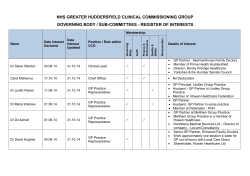
Faculté des Arts et des Sciences
McGill Chemical Society Dr. Stuart J. Rowan Case Western Reserve U., Dept of Macromolecular Sc. and Eng., Cleveland, OH Using Dynamic Chemistry as a Route to New Stimuli-Responsive Materials Tuesday April 7th, 2015 1:00pm Otto Maass room 10 The dynamic bond can be defined as any class of bond that selectively undergoes reversible breaking and reformation, usually under equilibrium conditions. The incorporation of dynamic bonds (which can be either covalent or non-covalent) allows access to structurally dynamic polymers.1 Such polymers can exhibit macroscopic responses upon exposure to an environmental stimulus, on account of a rearrangement of the polymeric architecture. In such systems the nature of the dynamic bond not only dictates which stimulus the material will be responsive to but also plays a role in the response itself. Thus such a design concept represents a molecular level approach to the development of new stimuli-responsive materials. We have been interested in the potential of such systems to access new material platforms and have developed a range of new mechanically stable, supramolecular structurally dynamic polymer films that change their properties in response to a given stimulus, such as temperature, light or specific chemicals. Such supramolecular materials have been targeted toward applications that include healable plastics,2,3,4 responsive liquid crystalline polymers,5 chemical sensors,6 thermally responsive hydrogels,7 shape memory materials8 and mechanically dynamic biomedical implants.9,10 In this presentation we will focus on two classes of stimuli-responsive materials (1) photo-healable/shape-memory materials and (2) mechanically dynamic cortical implants. References: 1. Wojtecki, R.J.; Meador, M.A.; Rowan S.J. “Utilizing the Dynamic Bond to Access Macroscopically-Responsive Structurally-Dynamic Polymers” Nature Materials 2011, 10, 14-27. 2. Burnworth, M.; Tang, L.; Kumpfer, J.R., Duncan, A. J., Beyer, F.L.; Fiore, G.L.; Rowan S.J.; Weder, C. “Optically Healable Supramolecular Polymers” Nature 2011, 472, 334-337. 3. Fox, J.; Wie, J.J.; Greenland, B.W.; Burattini, S.; Hayes, W.; Colquhoun, H.M.; Mackay, M.E.; Rowan S.J. “High-Strength, Healable, Supramolecular Polymer Nanocomposites” J. Am. Chem. Soc. 2012, 134, 5362-5368. 4 Michal, B.T.; Jaye, C.A. Spencer, E.J.; Rowan, S.J. “Inherently Photo-Healable and Thermal Shape-Memory Polydisulfide Networks” ACS Macro Lett. 2013, 2, 694-699. 5. McKenzie, B.M.; Wojtecki, R.J.; Burke, K.A.; Zhang, C.; Jákli, A.; Mather, P.T. Rowan, S.J. “Metallo-Responsive Liquid Crystalline Monomers and Polymers” Chem. Mater. 2011, 23, 3525-3533. 6. Kumpfer, J.R.; Jin, J.; Rowan, S.J. “Stimuli-responsive europium-containing metallo-supramolecular polymers” J. Mater. Chem. 2010, 20, 145-151. 7. Buerkle, L.E.; von Recum, H.A.; Rowan S.J. “Toward Potential New Supramolecular Tissue Engineering Scaffolds Based on Guanosine Derivatives” Chem. Sci. 2012, 3, 564-572. 8. Kumpfer, J.R.; Rowan, S.J. “Thermo-, Photo- and Chemo-Responsive Shape-Memory Properties from Photo-Crosslinked Metallo-Supramolecular Polymers” J. Am. Chem. Soc. 2011, 133, 12866-12874.9 Capadona, J.R.; Shanmuganathan, K.; Tyler D.J.; Rowan S.J.; Weder, C. “Stimuli-Responsive Polymer Nanocomposites Inspired by the Sea Cucumber Dermis” Science 2008, 319, 1370-1374. 10 Capadona J.R.; Tyler, D.J.; Zorman C.A.; Rowan, S.J.; Weder, C. Mechanically Adaptive Nanocomposites for Neural Interfacing MRS Bulletin 2012, 37, 581-589.
© Copyright 2025











